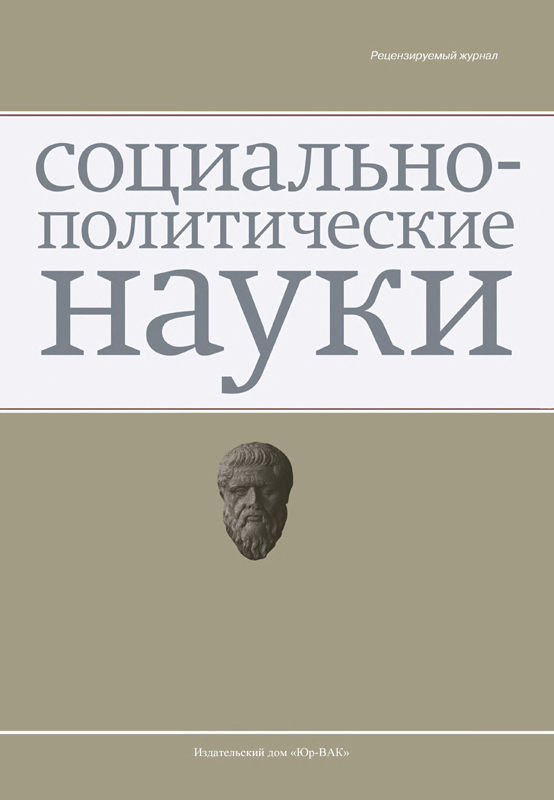State Strategy to Support Active Longevity and Physical Activity of Elderly Citizens
- Authors: Voronina L.I.1, Zaitseva E.V.1, Kasyanova Т.I.1
-
Affiliations:
- Ural Federal University
- Issue: Vol 12, No 4 (2022)
- Pages: 195-207
- Section: Articles
- URL: https://journals.eco-vector.com/2223-0092/article/view/535905
- DOI: https://doi.org/10.33693/2223-0092-2022-12-4-195-207
- ID: 535905
Cite item
Abstract
Keywords
Full Text
About the authors
Ludmila I. Voronina
Ural Federal University
Email: l.i.voronina@urfu.ru
Cand. Sci. (Sociol.); associate professor at the Department of Theory, Methodology and Legal Support of State and Municipal Administration Yekaterinburg, Russian Federation
Ekaterina V. Zaitseva
Ural Federal University
Email: e.v.zaitceva@urfu.ru
Cand. Sci. (Sociol.), Associate Professor; associate professor at the Department of Theory, Methodology and Legal Support of State and Municipal Administration Yekaterinburg, Russian Federation
Тatyana I. Kasyanova
Ural Federal University
Email: tatiana.kasianova@urfu.ru
PhD in Pedagogy; associate professor at the Department of Theory, Methodology and Legal Support of State and Municipal Administration Yekaterinburg, Russian Federation
References
- Astashova Yu.V. Social gerontomarketing in the healthcare sector: Essence, key tasks, interaction with target audiences. Bulletin of SUSU. Series: Economics and Management. 2019. Vol. 13. No. 4. Pp. 149-155.
- Vasilyeva E.N., Mosina O.A. Resource potential of the “elderly”: Implementation technologies. Modern Problems of Science and Education. 2014. No. 1. Pp. 458-458.
- Golushko T.V., Khutin S.A. Maintaining the physical qualities of older people by means of selective motor activity. Scientific Works of the North-Western Institute of Management. 2021. Vol. 12. No. 2 (49). Pp. 89-94.
- Grigoryeva I., Bogdanova E. The concept of active aging in Europe and Russia in the face of the COVID-19 pandemic. Laboratorium: Journal of Social Research. 2020. No. 2. Pp. 187-209.
- Davydov E.L., Tikhonova N.V., Glushanko V.S. et al. Syndrome of senile asthenia: features of diagnosis, treatment and rehabilitation. Siberian Medical Review. 2020. No. 5 (125). Pp. 40-48. doi: 10.20333/2500136-2020-5-40-48.
- Zaitseva E.V., Volynskaya M.M. Resocialization of citizens of the third age through recreational and physical culture services. Bulletin of Economics, Law and Sociology. 2020. No. 1. Pp. 112-116.
- Kasarkina E.N. The dependence of the social adaptation of older people on their needs and opportunities for physical education [Electronic resource]. Scientific Notes of the St. Petersburg State Institute of Psychology and Social Work. 2017. No. 2. Pp. 100-105.
- Kirichenko N.V., Baklushina E.K., Moiseenkov D.I., Paykova A.S. Status and problems of organizing geriatric care in a region with an “old” age structure of the population (on the example of the Ivanovo region). Bulletin of the Ivanovo Medical Academy. 2018. Pp. 6-10.
- The concept of active longevity policy: Scientific and methodological report: To the 21st April International Scientific Conference on the Problems of the Development of the Economy and Society. L.N. Ovcharova, M.A. Morozova, O.V. Sinyavskaya (eds.). Moscow: Higher School of Economics, 2020. 40 p. ISBN 978-5-7598-2173-1.
- Krasnova O.V. Workshop on work with the elderly. Moscow: Printer, 2017. 231 p. ISBN 986-6185-63-3.
- Loseva P. Counterclockwise: What is aging and how to deal with it. Moscow: Alpina non-fiction, 2020. 470 p. ISBN 978-5-00139-143-2.
- Popov V.V. et al. Early diagnosis and prevention of age-associated disorders in elderly and senile people living in the European North of Russia. Profilakticheskaya Meditsina. 2019. Vol. 22. No. 3. Pp. 73-78. doi: 10.17116/profmed20192203173
- Potapova I.A. Typological features of social adaptation and maladaptation of elderly people. Society: Sociology, Psychology, Pedagogy. 2015. No. 7. Pp. 36-41.
- Shinkai S., Yoshida H., Taniguchi Y. et al. Public health approach to preventing frailty in the community and its effect on healthy aging in Japan // Geriatrics & Gerontology International. 2016. Vol. 16. Pp. 87-97. doi: 10.1111/ggi.12726.
- Tamura Y., Ishikawa J., Fujiwara Y. et al. Prevalence of frailty, cognitive impairment, and sarcopenia in outpatients with cardiometabolic disease in a frailty clinic // BMC Geriatrics. 2018. Vol. 18. No. 1. Pp. 745-752. doi: 10.1186/s12877-018-0955-4.
- Weiss O.C. Frailty and chronic diseases in older adults // Clin. Geriatr. Med. 2011. Vol. 27. Pp. 39-52.
Supplementary files









